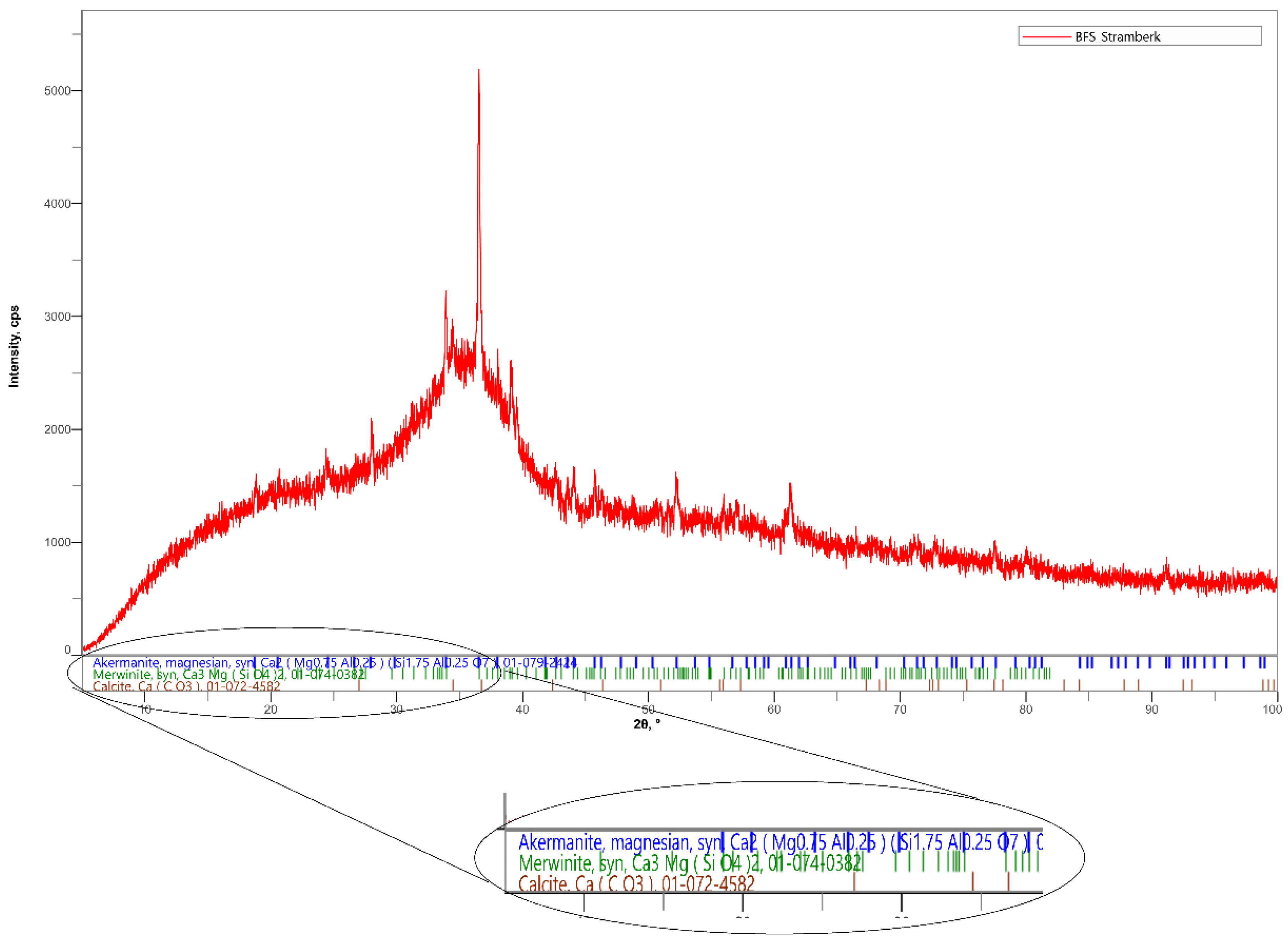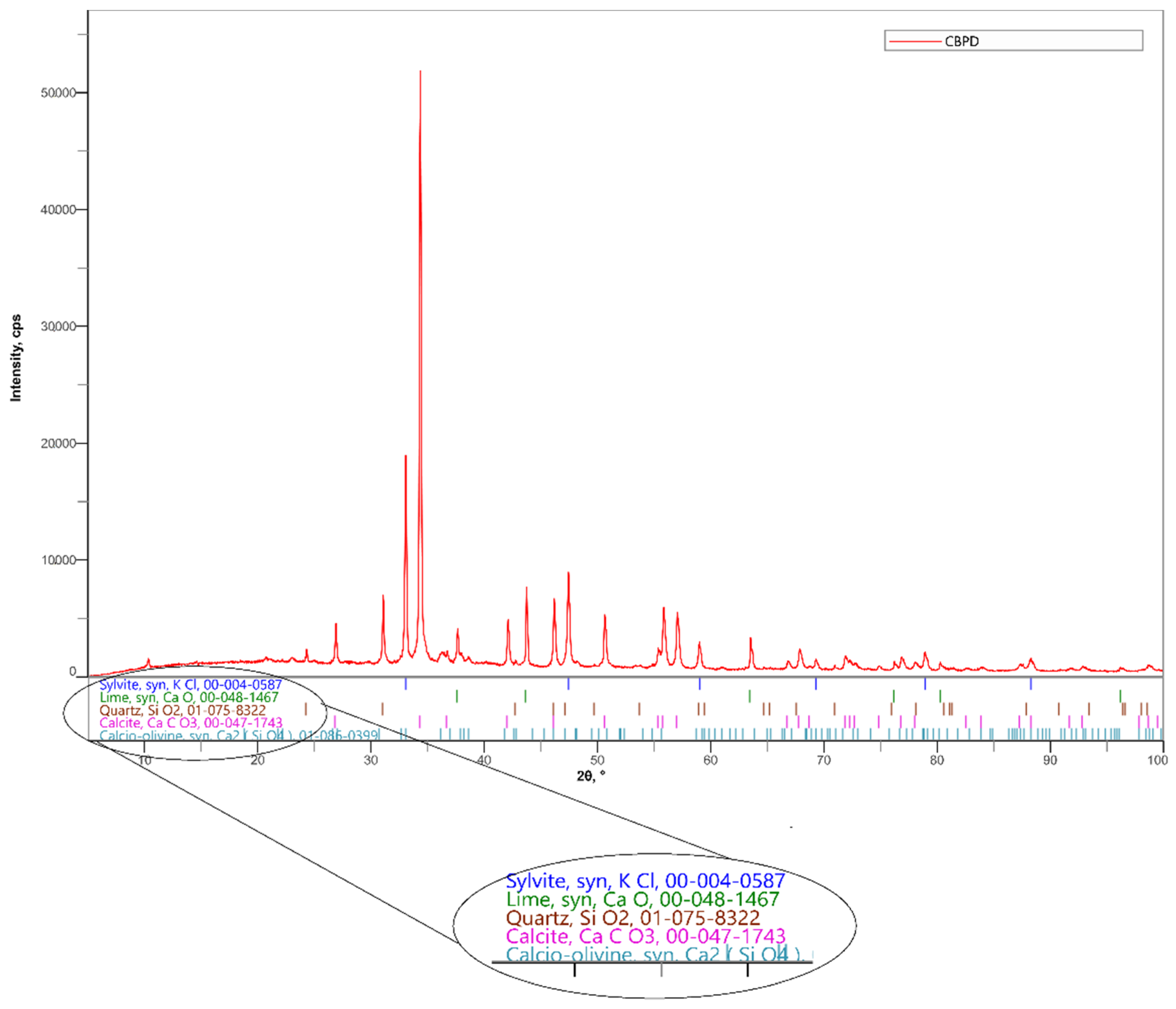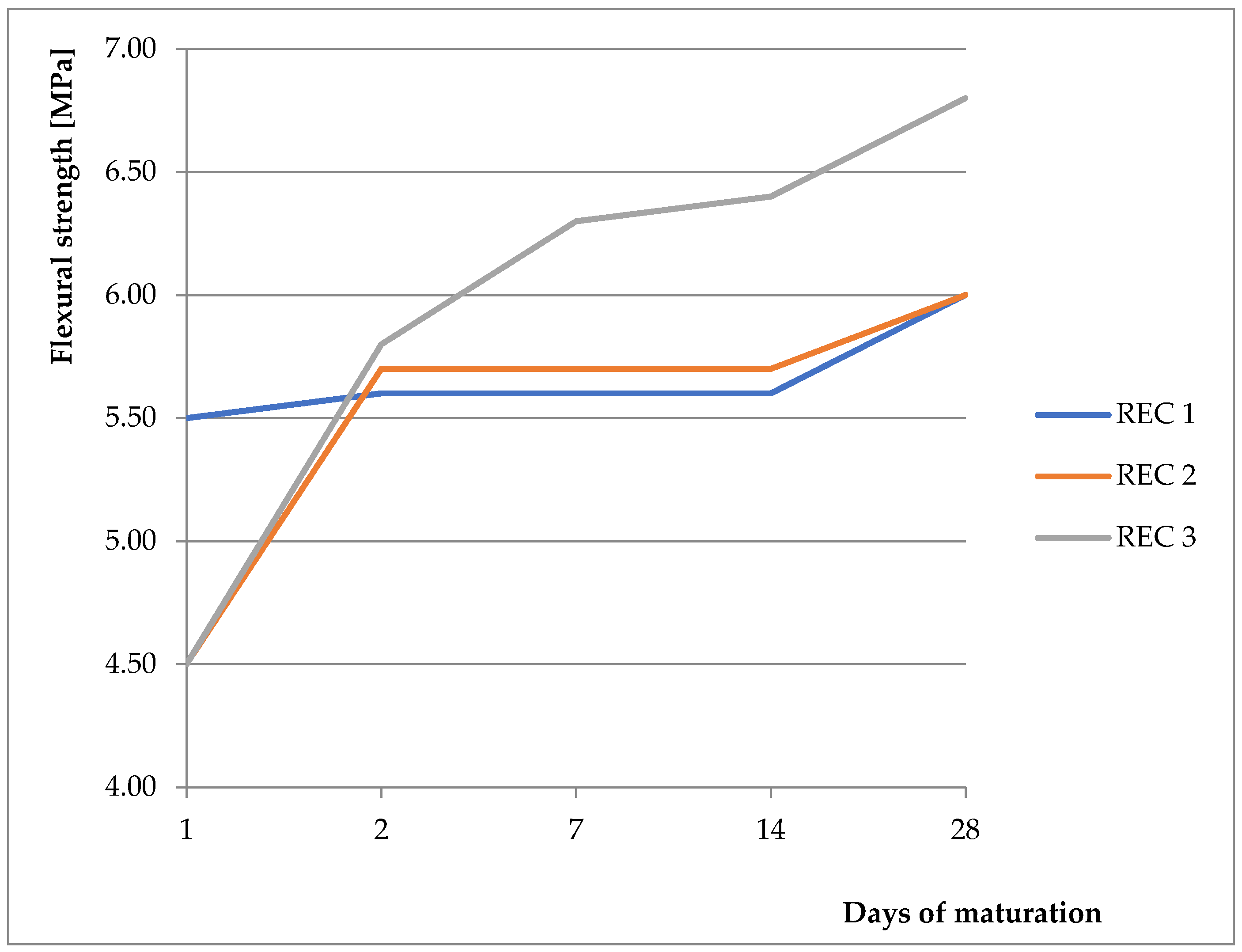X-ray Diffraction of Alkali-Activated Materials with Cement By-Pass Dust
Abstract
:1. Introduction
2. Materials and Methods
2.1. Blast-Furnace Granulated Slag (BFS)
2.2. Silica Fly Ash (FA)
2.3. Cement By-Pass Dust (CBPD)
2.4. Activator—Anhydrous Disodium Metasilicate (A)
2.5. Standardized Sand
2.6. Mixture Preparation
2.7. X-ray Diffraction
2.8. Strength
3. Results
4. Discussion
5. Conclusion
Author Contributions
Funding
Acknowledgments
Conflicts of Interest
References
- Chen, C.; Habert, G.; Bouzidi, Y.; Jullien, A. Environmental impact of cement production: Detail of the different processes and cement plant variability evaluation. J. Clean. Prod. 2010, 18, 478–485. [Google Scholar] [CrossRef]
- Altwair, N.; Kabir, S. Reducing Environmental Impacts through Green Concrete Technology. In Proceedings of the The 3rd Technology and Innovation for Sustainable Development International Conference (TISD2010) 2010, Faculty of Engineering, Khon Kaen University, Khon Kaen, Thailand, 4–6 March 2010. [Google Scholar]
- Bílek, V.; Khestl, F.; Mec, P. Hybrid Cements with Non Silicate Activators. Solid State Phenom. 2017, 259, 30–34. [Google Scholar] [CrossRef]
- Van Deventer, J.S.; Provis, J.L.; Duxson, P. Technical and commercial progress in the adoption of geopolymer cement. Miner. Eng. 2012, 29, 89–104. [Google Scholar] [CrossRef]
- Provis, J.L. Alkali-activated materials. Cem. Concr. Res. 2018, 114, 40–48. [Google Scholar] [CrossRef]
- Bílek, V.; Pytlík, D.; Bambuchova, M. High Performance Concrete with Ternary Binders. Key Eng. Mater. 2018, 761, 120–123. [Google Scholar] [CrossRef]
- Dyer, T.; Halliday, J.E.; Dhir, R.K. An investigation of the hydration chemistry of ternary blends containing cement kiln dust. J. Mater. Sci. 1999, 34, 4975–4983. [Google Scholar] [CrossRef]
- Provis, J.L.; Deventer, J.S.J. Geololymers, Structure, Processing, Properties and Industrial Applications; Woodhead Publishing Limited: Sawston, UK, 2009; ISBN 978-1-84569-449-4. [Google Scholar]
- Boháčová, J. Study of Influence of Different Types of Fillers on Properties of Geopolymer Systems Based on Alkali Activated Slags. Bachelor’s Thesis, VŠB—Technical University of Ostrava, Ostrava, Czech Republic, 2008; pp. 30–32. [Google Scholar]
- Kumar, S.; Kumar, R.; Mehrotra, S.P. Influence of granulated blast furnace slag on the reaction, structure and properties of fly ash based geopolymer. J. Mater. Sci. 2010, 45, 607–615. [Google Scholar] [CrossRef]
- Li, Z.X.; Tang, J.W. The Appropriate Chemical Admixture for Alkali-Activated Cementitious Material. Adv. Mater. Res. 2012, 534, 34–41. [Google Scholar] [CrossRef]
- Chen, K.; Yang, C.H.; Wu, F.; Ye, J.X.; Pan, Q.; Yu, Z.D. Development of Alkali Activated Slag Cement Based Ecomaterial and its Environmental Coordination Evaluation. Mater. Sci. Forum 2009, 610–613, 179–184. [Google Scholar] [CrossRef]
- Chi, M.C.; Chen, H.; Weng, T.L.; Huang, R.; Wang, Y.C. Durability of Alkali-Activated Fly Ash/Slag Concrete. Mater. Sci. Forum 2017, 904, 157–161. [Google Scholar] [CrossRef]
- Li, Z.; Liu, X.M.; Yang, D.H.; Qin, W.J.; Yang, G.S.; Zhang, D.L. Research of the SNCR Process and its Application. Adv. Mater. Res. 2014, 953–954, 1307–1314. [Google Scholar] [CrossRef]
- Procházka, L.; Boháčová, J. Verification of Durability Properties of Alkali-Activated Materials Based on Blast Furnace Slag with Fly Ash. Solid State Phenom. 2020, 309, 93–97. [Google Scholar] [CrossRef]
- Procházka, L.; Mec, P. Possibility of using fly ash after denitrification by SNCR as admixture in alkali-activated materials. Mater. Today Proc. 2021, 37, 42–47. [Google Scholar] [CrossRef]
- Štěpánková, E.; Kalina, L.; Belik, V., Jr.; Bartoníčková, E. Utilization of By-Pass Cement Kiln Dust in Alkali-Activated Materials. Key Eng. Mater. 2018, 761, 23–26. [Google Scholar] [CrossRef]
- Tkaczewska, E. The influence of cement bypass dust on the properties of cement curing under normal and autoclave conditions. Struct. Environ. 2019, 11, 5–22. [Google Scholar] [CrossRef]
- Ahmari, S.; Zhang, L. Utilization of cement kiln dust (CKD) to enhance mine tailings-based geopolymer bricks. Constr. Build. Mater. 2013, 40, 1002–1011. [Google Scholar] [CrossRef]
- Kubátová, D.; Rybová, A.; Zezulová, A. The Hydrothermal Stability of Alkali-Activated Fly Ash/Slag Pastes by the Incorporation of Cement Kiln Dust. Solid State Phenom. 2019, 296, 15–20. [Google Scholar] [CrossRef]
- Sikorová, V. Methods of Using Cement Kiln By-Pass Dust in Building Materials Technology. Master’s Thesis, Faculty of Chemistry, Brno University of Technology, Brno-Medlánky, Czech Republic, 2019; pp. 33–38. [Google Scholar]
- Adaska, P.W.S.; Taubert, D.H. Beneficial Uses of Cement Kiln Dust. In Proceedings of the 2008 IEEE Cement Industry Technical Conference Record, Miami, FL, USA, 18–22 May 2008; pp. 210–228. [Google Scholar]
- Kotouč Štramberk. 2020. Available online: https://www.cemix.cz/kotouc/cz (accessed on 15 September 2020).
- Ismail, I.; A Bernal, S.; Provis, J.L.; Hamdan, S.; Van Deventer, J.S.J. Microstructural changes in alkali activated fly ash/slag geopolymers with sulfate exposure. Mater. Struct. 2013, 46, 361–373. [Google Scholar] [CrossRef]
- Procházka, L.; Boháčová, J. Effect of Admixtures on Durability Characteristics of Fly Ash Alkali-activated Material. Emerg. Sci. J. 2020, 4, 493–502. [Google Scholar] [CrossRef]
- Penta. Chemical Unlimited—Chemikalie 2020. Available online: https://www.pentachemicals.eu/chemikalie (accessed on 15 September 2020).
- ČSN EN 196-1 Methods of Testing Cement—Part 1: Determination of Strength Prague; Classifier 72 2100; Office for Technical Standardization, Metrology and State Testing: Prague, Czech Republic, 2005; pp. 5–40.
- Koňařík, J. Influence of Activator on Basic Properties of Alkali Activated Systems. Bachelor’s Thesis, VŠB—Technical University of Ostrava, Ostrava, Czech Republic, 2014; pp. 27–35. [Google Scholar]
- Mec, P.; Boháčová, J.; Závrský, P. Testing of Possible Use of Fine-Grained Alkali Activated Composites in the Construction Industry. Mater. Sci. Forum 2016, 865, 47–52. [Google Scholar] [CrossRef]
- Bohacova, J.; Janalík, L. Preparation and Verification of Properties of Alkali-Activated Composite. Solid State Phenom. 2019, 296, 209–214. [Google Scholar] [CrossRef]
- Aydın, S.; Baradan, B. Effect of activator type and content on properties of alkali-activated slag mortars. Compos. Part B Eng. 2014, 57, 166–172. [Google Scholar] [CrossRef]
- Amer, I.; Kohail, M.; El-Feky, M.; Rashad, A.; Khalaf, M.A. A review on alkali-activated slag concrete. Ain Shams Eng. J. 2021, 12, 1475–1499. [Google Scholar] [CrossRef]






| Oxide | Content [%] | ||
|---|---|---|---|
| FA | BFS | CBPD | |
| SiO2 | 50.89 | 33.81 | 5.32 |
| Al2O3 | 21.34 | 8.14 | 1.46 |
| Fe2O3 | 9.49 | 0.32 | 1.22 |
| CaO | 4.48 | 46.16 | 34.08 |
| SO3 | 0.58 | 1.46 | 5.16 |
| K2O | 3.14 | 0.42 | 18.62 |
| MgO | 1.67 | 7.86 | 0.48 |
| LOI | 6.27 | 0.00 | 21.90 |
| Participant | Content [%] |
|---|---|
| Sylvite | 21.9 |
| Free CaO | 22.4 |
| Portlandite | 15.0 |
| Arcanite | 14.4 |
| Quartz | 4.02 |
| Larnite/Belite | 19.2 |
| Alunite | – |
| Hatrurite/Alite | – |
| Ferrite | – |
| Mayenite | – |
| Calcite | 1.36 |
| Dolomite | 1.67 |
| A | MJ | Value |
|---|---|---|
| SiO2 content | % | min. 44 |
| pH | - | 12.5 |
| Molar weight | kg/mol | 122.06 |
| Relative density | g/cm3 | 2.6 |
| Mixture | Units | BFS | FA | CBPD | A | W | Sand | Σ |
|---|---|---|---|---|---|---|---|---|
| REC 1 | g | 315 | 67.5 | 67.5 | 89.00 | 215 | 1350 | 2104.00 |
| wt% | 14.97 | 3.21 | 3.21 | 4.23 | 10.21 | 64.16 | 100 | |
| REC 2 | g | 315 | 67.5 | 67.5 | 75.65 | 215 | 1350 | 2090.65 |
| wt% | 15.07 | 3.23 | 3.23 | 3.62 | 10.28 | 64.57 | 100 | |
| REC 3 | g | 315 | 67.5 | 67.5 | 62.30 | 215 | 1350 | 2077.30 |
| wt% | 15.16 | 3.25 | 3.25 | 3.00 | 10.35 | 64.99 | 100 |
Publisher’s Note: MDPI stays neutral with regard to jurisdictional claims in published maps and institutional affiliations. |
© 2021 by the authors. Licensee MDPI, Basel, Switzerland. This article is an open access article distributed under the terms and conditions of the Creative Commons Attribution (CC BY) license (https://creativecommons.org/licenses/by/4.0/).
Share and Cite
Vojvodíková, B.; Procházka, L.; Boháčová, J. X-ray Diffraction of Alkali-Activated Materials with Cement By-Pass Dust. Crystals 2021, 11, 782. https://doi.org/10.3390/cryst11070782
Vojvodíková B, Procházka L, Boháčová J. X-ray Diffraction of Alkali-Activated Materials with Cement By-Pass Dust. Crystals. 2021; 11(7):782. https://doi.org/10.3390/cryst11070782
Chicago/Turabian StyleVojvodíková, Barbara, Lukáš Procházka, and Jana Boháčová. 2021. "X-ray Diffraction of Alkali-Activated Materials with Cement By-Pass Dust" Crystals 11, no. 7: 782. https://doi.org/10.3390/cryst11070782






